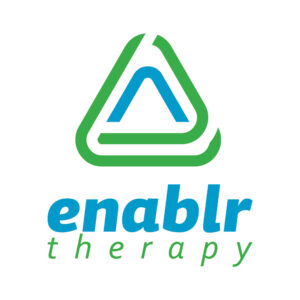
Speech therapy is a term referring to more than just one service. Speech and language pathologists, or SLPs, tailor their programming to fit the needs of each client. Today, we’ll explore the different diagnoses treated by Enablr-certified therapists.
Apraxia
Apraxia means that clients, usually children, have a motor disorder that makes it difficult to voice their thoughts. They know what they want to convey, but struggle to produce the proper sounds or words. This disorder may also co-occur with concerns like writing, reading, or swallowing issues. Without clinical intervention, apraxia may linger. SLPs evaluate clients for this condition, then provide guidance and helpful exercises to improve symptoms.
Aphasia Treatment
Aphasia is an acquired language disorder that results from an injury to the language center of the brain. Strokes, tumors, traumatic brain injuries, and brain infections are common causes. Those with aphasia exhibit challenges with language in many ways including speaking, reading, writing, and understanding what is said. As the mind heals and the client learns new tactics for managing their communication, both adult and pediatric clients can make great strides.
Therapy for Swallowing
While most people assume that our therapists solely focus on speaking, swallowing is another popular type of speech therapy. The fine motor control used for talking is also required for consuming food and water. Speech therapists empower children and adults by demonstrating exercises that build strength and dexterity.
Fluency Disorders and Stuttering
Stuttering usually begins in childhood, and it can be incredibly frustrating! When kids struggle to get the right words out, they may feel embarrassed or helpless. A certified SLP will help your child to control their rate of speech, monitor their breathing, and improve their fluency.
Articulation
Many children struggle to pronounce certain sounds—usually “r” and “s.” These sounds may be completely dropped, added in, substituted for another sound, or distorted in some way. Speech therapists work one-on-one with these clients to overcome articulation disorders so that family and friends can easily understand them.
Speech Therapy for Late Talkers
Parents naturally grow concerned when their child misses developmental milestones. If your son or daughter hasn’t started talking, they may benefit from speech therapy. A speech therapist can encourage your infant or toddler to begin talking through a variety of interventions, including play, incorporating favorite toys, and the use of other types of communication.
Gerontology: OT For Older Adults
- To safely age in their own homes
- To cope with neurological disorders like strokes and dementia
- To prevent falls
- To recover from surgeries or illness
- To compensate for declines in vision, strength, endurance, or motion associated with aging
Feeding, Eating, And Swallowing
Many conditions can erode a person’s ability to properly consume solid foods. Issues in this area can be especially upsetting because this particular ADL (activity of daily living) is crucial survival and a common way to socially interact with others. OTs facilitate this process by addressing sensory concerns, providing adaptive equipment as needed, and educating both clients and families about techniques that promote safe eating.
OT For Autism
Some therapists work specifically with children, adolescents, and adults on the autism spectrum. Autism spectrum disorder (ASD) is often characterized by social difficulties and sensory processing issues. Occupational therapists specializing in autism help clients to practice fine motor skills, independent self-care, play, and social interactions.
PT is an exciting, ever-changing field. As researchers develop new and innovative treatment tactics, various specialties continue to emerge. Here are just a few of the major types of physical therapy available from licensed, certified professionals nationwide.
Pediatric physical therapists specialize in meeting the needs of children. Often, this includes strength-building for kids, preteens, and teenagers experiencing rapid growth. Other young people may need help overcoming developmental challenges and hereditary disorders. Additionally, many pediatric clients require assistance overcoming acute sports injuries. Our PTs are experts at making each session both fun and engaging, no matter how old your child is.
On the other end of the age spectrum, you’ll find geriatric physical therapists. These specialists help older adults navigate age-related issues like osteoporosis, joint replacement, arthritis, and fall prevention. Clients participating in geriatric PT often regain more than just mobility—they develop skills that contribute to their independence, too.
When someone thinks of PT, they probably picture orthopedic treatment. This approach focuses on the musculoskeletal system, especially the knees, shoulders, elbows, bones, and tendons. Physical therapists work to restore function for those dealing with sports injuries, joint problems, or torn ligaments. This approach is also vital for people struggling with common back issues like lumbar pain, herniated discs, scoliosis, and muscle strain.
Orthopedic physical therapy usually includes a blend of endurance exercises, strength training, and stretching. However, each session is tailored to the client’s unique needs.
Neurological Physical Therapy
Often, neurological conditions affect a person’s ability to move and function. Physical therapy provides guidance for those dealing with impairments caused by Parkinson’s disease, traumatic brain injury, stroke, or Alzheimer’s. With careful assistance, each individual can improve their quality of life and adapt to their environment.
Cardiovascular And Pulmonary Physical Therapy
Also called cardiopulmonary PT, this approach focuses on assisting clients who have heart or lung issues. Such conditions include asthma, chronic obstructive pulmonary disease (COPD), coronary stents, cystic fibrosis, emphysema, and lung cancer. Physical therapy for improved cardiovascular and pulmonary function often involves therapeutic exercise and chest percussion, as well as postural drainage.
Vestibular Rehabilitation
Vestibular rehabilitation therapy, or VRT, is an emerging area of study among physical therapists. It is indicated for conditions like vertigo, stable vestibular lesions, head injury, and dizziness among older adults. Ideally, this exercise-based approach helps clients to address their symptoms and enhance their stability in everyday life.
Pelvic Health Therapy
The pelvic floor controls your bladder, bowels, and reproductive system. Some people begin to experience trouble in this area due to pregnancy, age, weight gain, surgery, or injury. Issues can include frequent urination, constipation, incontinence, erectile dysfunction in men, and painful intercourse among women. Often, strengthening these muscles provides relief from these symptoms.
Pelvic floor rehabilitation is conducted by PTs who specialize in this area. Using Kegel exercises, electrical stimulation, and trigger point therapy, physical therapists can help clients to build strength and alleviate the symptoms of a weak pelvic floor.
Thrive with Enablr Therapy
Therapy traditionally takes place within an office or school. Today, things have changed for the better. Enablr Therapy brings this crucial service into your home via teleconferencing. If you need therapy, or if your child does, we invite you to browse our network of qualified therapists. If you have any questions, please fill out the form below. We look forward to working with you!
Need more help? Write to us.
Whether your child stutters or has difficulty processing what others say, help is here. We have the answers you need. Enablr Therapy connects you with proven professionals who specialize in pediatric speech therapy. Through one-on-one sessions, comprehensive support, and compassionate service, we aim to make a difference in your child’s life.


